Analysis-Russian Risks Stoke Fears For European Winter Gas Supplies

Europe will need to secure large quantities of gas if it wants to avoid soaring prices and crippling energy bills next winter in the event of disruption to flows from Russia.
Already high wholesale gas and power prices spiked this week when Germany halted certification for the Nord Stream 2 pipeline which bypasses Ukraine to transport gas from Russia to Europe, and on Moscow's military move against Kyiv.
Russia, which supplies around 40% of Europe's gas, has said it will continue to deliver natural gas to world markets and analysts say sanctions against Russian gas imports in response to its invasion of Ukraine this week are unlikely.
But there is a risk of damage to pipelines or Russia interrupting the transit of gas through Ukraine. This would hit Europe hard as fully replacing Russian gas is not seen as a viable option for the region, at least in the short term.
There are also fears that buyers will struggle to secure guarantees at Western banks or pay for gas if Russia is excluded from international payment systems.
"Europe would have to pull every lever to keep the lights on - reducing gas burn and cranking up mothballed nuclear and coal plants; maximising indigenous gas production and pipeline imports," Wood Mackenzie analyst Kateryna Filippenko said of possible disruption to supplies from Russia.
But these would be temporary fixes, leaving Europe with "perilously low storage volumes" going into winter, Filippenko said, adding that winter prices "could be higher than 2021/22".
This winter season, which runs to the end of March, has seen gas and power prices in Europe reach record highs due to low gas inventories, lower Russian gas supply, outages and global competition for liquefied natural gas (LNG).
"End-2022 and going into 2023 may see prices closer to the 2021 winter and could be higher," Kaushal Ramesh, analyst at Rystad Energy, said of the outlook for gas prices in Europe.
Although Dutch gas prices, the European benchmark, are below the record highs hit in December, they spiked by up to 60% on Thursday after Moscow's move on Ukraine. [NG/EU]
Record power prices have already bankrupted energy retailers in many countries, leaving consumers with steep bill increases and a smaller pool of suppliers to choose from.
High power prices are also a major factor behind soaring inflation and have led European governments to spend billions of euros shielding consumers.
BUFFER
Although a mild late winter and a flurry of LNG supply, particularly from the United States, has helped European storage levels to recover from record lows, they remain at a five-year low of around 30% full, Gas Infrastructure Europe data shows.
However, tight supplies and the potential for disruptions to Russian flows mean Europe needs a bigger buffer to avoid what starting winter with storage at 10-year lows.
"It's very likely that nobody will be able to pump into storage even at current prices," a trader at a utility active in Ukraine and central eastern Europe said.
The Nord Stream 2 pipeline had been due to start pumping around 10 billion cubic metres (bcm) of gas later this year and this had been expected to rise to 40 bcm next year, equivalent to around 7% of European gas supply.
(GRAPHIC: North-west European gas stocks -

)
EUROPEAN OPTIONS
A draft document seen by Reuters shows the European Commission wants to compel countries to ensure a minimum level of storage by the end of September every year.
Details are expected to be published next week.
Nations such as Italy and Germany are already studying measures to ensure minimum storage levels.
Higher supplies could come from Azerbaijan, which plans to pump 16.2 bcm through the Trans-Anatolian Natural Gas Pipeline going through Turkey to southern Europe.
Rystad Energy forecasts 2022 LNG production at around 410 million tonnes per annum (mtpa), 25 mtpa higher than in 2021.
"There is enough LNG demand within Europe alone to absorb the entire 25 mtpa of incremental production in the event of a disruption in Russian flows," Rystad's Ramesh said.
North-west Europe is likely to be the top destination for U.S. LNG shipments for the third month running, but its LNG regasification terminals have limited capacity.
Qatar has said it does not have capacity to fully replace Russian gas supplies with LNG.
Norwegian gas pipeline operator Gassco could defer maintenance to meet demand, which analysts at Jefferies said could add 5-7 bcm of supply. A spokesperson said Gassco looks at such possibilities and would publish any changes.
Meanwhile, Europe has increased its coal use in recent months, due to its comparatively cheaper price to gas, which could continue this year to bridge the gap.
© Copyright Thomson Reuters 2024. All rights reserved.




















